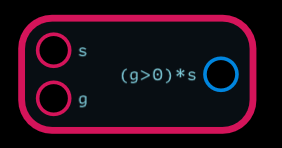It seems like velocity would just be a complex gate or envelope. I want to take some info from a MIDI controller and use Audulus to convert the signals to control the Eurorack.
To put it another way, can a gate and a velocity value be extracted from a control voltage? Or, can you cram two into one and then back into two? Again, if you have velocity it seems like a simple gate is redundant.
The velocity info is encoded into the amplitude of the gate coming out of the keyboard node. So you just attach the gate output to both inputs of a S&H node and it will update the velocity with each note on message and you can scale that to stepped cv.



Here’s the thing, I would like to go out of the ES-8 using only one jack. So it sounds like I multiply that ‘gate’ output into my pulp logic s&h?
It might be useful to discuss the difference between a signal used as gate and one used as a clock. A gate is any signal used to control the flow of another signal whereas a clock is used to provide timing information. Often the same signal serves both purposes.
Typically a gate is either on or off but that is not always the case. Consider the following expression:

When any positive signal is applied to the g input, the s signal is “gated” through to the output. This represents a typical gate. Some gate inputs behave like this and ignore the actual value of the gate so long as it’s positive.
If we simply multiply the signal by the gate, as the gate value increases, the amount of signal passed will also increase and, if the gate value exceed 1 may actually be larger than the input. This is a variable height gate. The “amp” input on the oscillator node represents this type of gate.
A clock signal is used to start or stop some event. In Audulus, clocks typically occur on the rising edge of a positive going signal. Since the critical information is the time when the signal goes from 0 to some positive value, the exact value of the clock is not normally important, nor is the time when it returns to zero. The input to the timer node is a good example.
As Robert indicated, the velocity output from the MIDI node is just a variable height gate. Remember that MIDI is just a stream of messages rather than floating point values as used in Audulus or the CV and audio signals used by eurorack gear. The MIDI node receives the incoming note-on message, extracts the velocity value from the message (0-127) and converts it to an Audulus signal. It also converts the MIDI note value to a frequency. By using these signal to control the output of an oscillator you can “play” a note.
When the signal from the MIDI node is applied to the input of an ADSR, it acts as both a variable gate and two clocks. The ADSR is clocked on when the gate goes positive, and the value of the gate determines the attack value of the ADSR. When the gate returns to zero another clock occurs and the release is triggered.
1 Like

